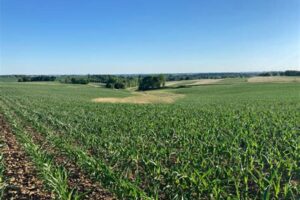Table of Contents
Ridge farming is an innovative agricultural technique that involves creating raised beds or ridges in the soil to optimize crop growth. This method improves drainage, prevents soil erosion, and enhances water conservation. Discover the benefits and implementation of ridge farming in sustainable and productive agriculture.
Ridge farming, also known as ridging or hilling, is an ancient agricultural technique that has been practiced for centuries across different parts of the world. This traditional farming method involves creating raised rows or ridges of soil, typically in a parallel formation, to cultivate crops. The use of ridges offers numerous benefits to farmers, ranging from improved soil drainage and moisture retention to better weed control and increased crop yields. Furthermore, ridge farming can be particularly advantageous in hilly or sloping terrains, as it helps prevent soil erosion and allows for efficient water management. As we delve deeper into the intricacies of ridge farming, we will explore its historical significance, ecological advantages, and its relevance in modern-day sustainable agriculture.
The Importance of Ridge Farming
Ridge farming is an agricultural technique that has been used for centuries in various parts of the world. It involves creating elevated ridges or mounds of soil to cultivate crops. This method has gained popularity due to its numerous benefits, including improved soil drainage, water conservation, and increased crop yields. In this article, we will explore the various aspects of ridge farming and its significance in modern agriculture.
What is Ridge Farming?
Ridge farming, also known as raised bed farming or hill farming, is a technique where farmers create raised rows or mounds of soil to plant their crops. These ridges are typically separated by furrows, which serve as channels for irrigation and drainage. The width, height, and spacing of the ridges vary depending on the specific requirements of the crops being grown and the environmental conditions of the area.
The Benefits of Ridge Farming
Ridge farming offers several advantages over traditional flat planting methods. Firstly, it improves soil drainage by preventing waterlogging, especially in areas with heavy rainfall or clayey soil. The elevated ridges allow excess water to flow away from the plants, reducing the risk of root rot and other water-related diseases.
Secondly, ridge farming helps conserve water by minimizing evaporation. The furrows between the ridges act as reservoirs, storing water and preventing its rapid loss. This is particularly beneficial in arid regions or during drought periods when water scarcity is a pressing issue.
Moreover, the raised beds of ridge farming provide better aeration and root development for the crops. The loose soil structure allows roots to penetrate deeper, accessing nutrients and moisture more efficiently. This results in healthier plants with stronger root systems, ultimately leading to increased crop yields.
Implementing Ridge Farming
To implement ridge farming, farmers need to prepare the land by plowing or tilling the soil. This loosens the soil and facilitates the creation of ridges. The ridges can be formed manually using hoes or mechanically through the use of specialized equipment, depending on the scale of the operation.
After forming the ridges, farmers usually apply organic matter, such as compost or manure, to enrich the soil with nutrients. This step helps maintain soil fertility and supports optimal plant growth throughout the growing season.
Once the ridges are prepared, farmers can sow seeds or transplant seedlings directly into the ridges. Care should be taken to space the plants appropriately to ensure optimal growth and access to sunlight, water, and nutrients.
Challenges of Ridge Farming
While ridge farming offers numerous benefits, it also presents some challenges that need to be addressed. One common challenge is erosion. The exposed ridges are more susceptible to erosion, especially in areas with heavy rainfall or steep slopes. Farmers can mitigate this issue by implementing erosion control measures, such as contour plowing or planting cover crops.
Another challenge is the initial investment required for equipment and infrastructure. Implementing ridge farming may require purchasing or renting specialized equipment, which can be costly for small-scale farmers. Additionally, the maintenance of furrows and ridges requires regular monitoring and upkeep.
Tips for Successful Ridge Farming
To ensure successful ridge farming, farmers should consider several factors. Firstly, selecting the appropriate crops for ridge farming is crucial. Vegetables, root crops, and certain fruits are well-suited for this technique due to their shallow root systems and high water requirements.
Secondly, proper irrigation management is essential. Farmers must provide adequate water to the plants while avoiding overwatering, which can lead to diseases and nutrient leaching. Irrigation systems, such as drip irrigation or sprinklers, can be employed to optimize water usage and minimize wastage.
Lastly, regular soil testing and fertilization are essential for maintaining soil health and productivity. By monitoring nutrient levels and pH, farmers can adjust their fertilizer application accordingly, ensuring optimal conditions for plant growth.
The Future of Ridge Farming
Ridge farming has proven to be a sustainable and efficient agricultural technique. As global food demand continues to rise and environmental concerns become more pressing, ridge farming is gaining attention as a viable solution. Its ability to conserve water, enhance soil health, and increase crop yields makes it an attractive option for farmers worldwide.
Moreover, ongoing advancements in agricultural technology and practices are further improving the efficiency and effectiveness of ridge farming. From precision planting to automated irrigation systems, these innovations are revolutionizing how farmers implement and benefit from this age-old technique.
In conclusion, ridge farming offers a multitude of benefits that make it a valuable tool in modern agriculture. By implementing this technique, farmers can improve soil drainage, conserve water, and achieve higher crop yields. While ridge farming may present some challenges, careful planning, proper maintenance, and continuous innovation can overcome them, ensuring its success for generations to come.
Introduction to Ridge Farming
Ridge farming is a sustainable agricultural technique that involves creating raised rows or mounds of soil, known as ridges, for crop cultivation. These ridges serve several purposes, such as increasing water drainage, reducing soil erosion, and improving soil fertility. Ridge farming has gained popularity among farmers due to its ability to optimize land productivity and protect natural resources.
Advantages of Ridge Farming
The utilization of ridges in farming offers various benefits. Firstly, it enhances water management by preventing soil erosion and providing better drainage, allowing crops to flourish even during heavy rainfall. Secondly, ridge farming reduces weed growth as the elevated rows make weed control more effective. Thirdly, the raised beds provide a favorable environment for root development, ultimately leading to increased crop yields.
Soil Conservation and Erosion Control
One of the key advantages of ridge farming is its ability to prevent soil erosion. The ridges act as barriers, preventing rainwater from directly flowing down slopes and carrying away valuable topsoil. By conserving soil, ridge farming safeguards the fertility of the land, increasing its long-term productivity and reducing the need for chemical fertilizers.
Improved Water Management
Another significant aspect of ridge farming is its impact on water management. The ridges elevate crops above the water level, preventing waterlogging and ensuring that excess water drains properly. This method significantly reduces the risk of crop damage caused by water saturation, thereby enhancing overall crop health and yield potential.
Increased Efficiency in Weed Control
Ridge farming helps combat weed growth more effectively than traditional farming methods. The raised rows make it easier to visually identify and manually remove weeds, minimizing their competition with crops for essential resources such as sunlight, water, and nutrients. This reduced weed pressure benefits both the yield and quality of the cultivated crops.
Enhanced Root Development
Crops grown on ridges experience improved root development compared to those grown on flat surfaces. The loose soil around the raised rows allows roots to penetrate deeper, accessing water and nutrients more efficiently. Well-developed root systems contribute to stronger and healthier crops that are better equipped to withstand adverse weather conditions and diseases.
Improved Crop Yields
Due to its holistic approach to farming, ridge farming is known to result in increased crop yields. The combination of optimized water drainage, reduced soil erosion, efficient weed control, and enhanced root development collectively contributes to improved plant health and productivity. Higher yields not only benefit farmers from an economic standpoint but also contribute to overall food security.
Potential for Sustainable Agriculture
Ridge farming aligns with the principles of sustainable agriculture by promoting long-term land productivity and resource conservation. It enables farmers to maximize output while minimizing the negative impacts on the environment. By adopting ridge farming techniques, farmers can contribute to a more sustainable and resilient agricultural ecosystem.
As a professional in the agricultural industry, I believe that ridge farming is an effective and efficient method of cultivation. It offers numerous benefits that contribute to sustainable and profitable farming practices. Below are the key points highlighting the advantages of ridge farming:
- Soil conservation: Ridge farming helps prevent soil erosion by creating raised beds or ridges, which act as barriers to water runoff. This method helps retain moisture in the soil and reduces the risk of nutrient leaching. By minimizing soil erosion, ridge farming helps maintain the fertility of the land and promotes long-term sustainability.
- Improved drainage: The raised ridges in ridge farming facilitate better drainage, especially in areas with heavy rainfall or high water table. Excess water can easily flow away from the plant roots, preventing waterlogging and reducing the risk of diseases caused by excessive moisture.
- Enhanced water management: Ridge farming allows for efficient water management as the ridges help conserve water within the planting area. This is particularly beneficial in regions with limited access to water resources or during drought periods. The ridges act as reservoirs, reducing water usage and ensuring optimal irrigation for crop growth.
- Increase in crop yields: The raised ridges provide a suitable microclimate for plants, allowing for better root development and optimal nutrient uptake. Ridge farming improves soil aeration, temperature regulation, and nutrient availability, resulting in increased crop yields. The improved drainage also prevents water stagnation, reducing the risk of root diseases and promoting healthy plant growth.
- Weed control: The ridges created in ridge farming provide a clear separation between the crop rows and the pathways. This facilitates easier weed management through mechanical or chemical means. The ridges act as physical barriers, restricting the growth and spread of invasive weeds, thus reducing competition for nutrients, water, and light.
- Time and labor efficiency: Ridge farming can save time and labor compared to traditional flatbed farming. The ridges serve as permanent planting beds, eliminating the need for frequent land preparation. This reduces the time spent on tilling, plowing, and leveling the field. Additionally, the defined pathways between the ridges make it easier for machinery and equipment to access the crop rows, further enhancing operational efficiency.
In conclusion, ridge farming is a highly advantageous cultivation method that promotes sustainable agriculture. It offers soil conservation, improved drainage, enhanced water management, increased crop yields, effective weed control, and time and labor efficiency. By adopting ridge farming practices, farmers can optimize their operations, maximize productivity, and contribute to the long-term viability of the agricultural industry.
Thank you for taking the time to visit our blog and learn more about ridge farming. We hope that you found the information provided to be informative and helpful in understanding this unique agricultural practice. In closing, we would like to summarize some key points discussed in the article.
First and foremost, ridge farming is a method of growing crops that involves creating raised beds or ridges in the field. These ridges not only help with water drainage but also provide better aeration for the plants’ root systems. By implementing ridge farming techniques, farmers can improve soil health and prevent waterlogging, which can be detrimental to crop growth.
Furthermore, ridge farming offers several advantages over traditional flatbed farming. The raised ridges allow for more efficient water usage as excess water can easily drain away. This is particularly beneficial in areas with heavy rainfall or clayey soils. Additionally, the increased aeration in the root zone promotes healthier plant growth and reduces the risk of diseases caused by water stagnation.
In conclusion, ridge farming is a sustainable agricultural practice that has gained popularity in recent years. Its numerous benefits make it an attractive option for farmers looking to optimize crop yields while minimizing environmental impact. By creating raised beds or ridges in their fields, farmers can improve soil health, enhance water drainage, and promote better plant growth. We encourage you to explore further resources on ridge farming and consider implementing this technique in your own farming practices.
We hope that this article has provided you with valuable insights into ridge farming. If you have any further questions or would like to share your own experiences with ridge farming, please feel free to leave a comment below. Thank you once again for visiting our blog, and we look forward to sharing more informative content with you in the future!
Video Ridge Farming
Here are some frequently asked questions about Ridge Farming:
What is Ridge Farming?
Ridge farming, also known as ridge tillage or ridging, is an agricultural technique that involves creating raised rows, or ridges, in a field to cultivate crops. It is commonly used for growing vegetables, such as potatoes, carrots, and onions, as well as for cash crops like maize and soybeans.
How is Ridge Farming different from traditional farming?
Ridge farming differs from traditional flatbed farming methods by creating ridges and furrows, which offer several advantages. These raised rows help improve water drainage and prevent soil erosion, especially on sloped fields. The ridges also provide better aeration to the plant roots, which can enhance crop growth and yield.
What are the benefits of Ridge Farming?
Ridge farming offers multiple benefits, including:
- Improved water management and reduced waterlogging
- Enhanced soil structure and reduced compaction
- Better weed control as the crops are concentrated on the ridges
- Increased soil warming, promoting early germination and growth
- Reduced labor and fuel requirements due to reduced tillage
Are there any challenges associated with Ridge Farming?
While ridge farming offers numerous benefits, it also presents some challenges that need to be addressed. These challenges include:
- Proper ridge formation and maintenance
- Selection of suitable crops and varieties for ridging
- Managing irrigation to prevent excessive moisture loss from ridges
- Adapting machinery and equipment for ridge cultivation
- Applying appropriate fertilization techniques for efficient nutrient uptake
Can Ridge Farming be used in all types of soils?
Ridge farming can be adapted to various soil types, but it is particularly beneficial for heavy or poorly drained soils. The ridges help improve soil drainage and aeration, which are essential for preventing waterlogging and promoting healthy plant growth. However, the suitability of ridge farming may vary based on specific soil conditions, and soil testing is recommended before implementation.
Remember, ridge farming practices may vary depending on the region and specific crop requirements. It’s always advisable to consult with local agricultural experts or extension services for personalized guidance.






